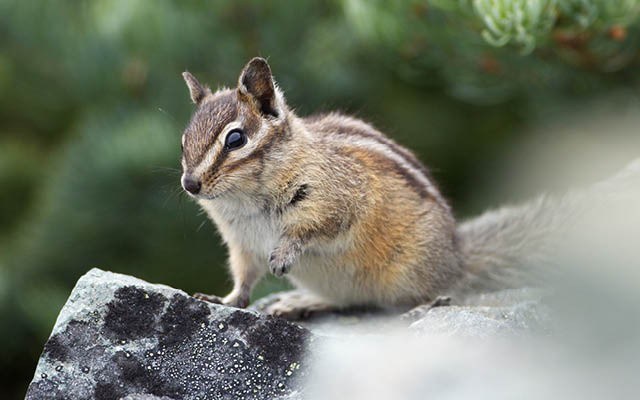Have you heard the saying, "good things come in small packages?" Well perhaps this famous statement best describes the small rodent that is found amidst the high elevations of Whistler's mountains, the Yellow-Pine Chipmunk.
This tiny, albeit adorable creature, puts a smile on the face of all who encounter it; but what do their lives entail outside of their mountainous run-ins with tourists and locals alike?
The Yellow-Pine Chipmunk (Neotamias amoenus) is a small species of rodent in the Sciuridae family. Predominately found in northwestern United States and southwestern Canada, these rodents thrive in locations 950 metres (or higher) above sea level with ample brush, rock crevices and tree logs.
They require these habitats for both nesting and protection from predation. Burrowing underground, these predominately solitary rodents build nests 18 centimetres to 53 centimetres below the surface in attempts to avoid their large range of predators including coyotes, bobcats and hawks.
Yellow-Pine Chipmunks range in size from 18 to 23 centimetres and usually weigh between 30 and 70 grams. It is not unusual for the females to be larger than the males.
A brownish-yellow to pinkish-cinnamon colour, these chipmunks dawn five distinctive longitudinal stripes down their back. The three middle stripes extend the full length of the back, while the outer two stripes dissipate mid-body.
An omnivore at heart, the chipmunk primarily ingests fruits, plants, seeds, insects and even small mammals. During the day, the chipmunks forage for food, cramming their findings deep into their cheeks for safe transport. Come early autumn, their search for instant gratification ceases, and the chipmunks begin to store food for the winter months. Some caches have been reported to contain over 68,000 items.
Are you wondering how these tiny rodents survive the long, cold Whistler winters? If you were thinking hibernation, you would be close but not completely correct. Rather, in late autumn the Yellow-Pine Chipmunks enter a four to five month torpor, which is best described as a period of low activity.
They emerge from their nests periodically over the winter months to eat the seeds that they have stored in their various caches. It is not until April that they re-emerge full-time, returning to their regular habits and routines.
Utilizing 10 different vocalizations, these chipmunks are usually heard before they are seen. So the next time you are up skiing or snowboarding on Whistler or Blackcomb, be sure to keep both your ears and eyes open, you may not be the only one enjoying the first signs of Spring.
Upcoming events:
Monthly bird walk — April 5: We'll meet at 8:00 a.m. at the foot of Lorimer Road and walk to Rainbow Park and back. For more information email Heather Baines at birdbaines@gmail.com.
Breeding Bird Survey — June 7: Meet at the Pony Espresso in Pemberton at 8:00 a.m. to join our crack team of birders as we comb the Pemberton Valley for interesting birds. For more information, email Bob Brett at bob@snowlineresearch.ca.
Erin Edwards is a Whistler Naturalists member. The Whistler Naturalists are a non-profit volunteer group dedicated to increasing local knowledge of the natural world in the Whistler area. For more information or to get involved please visit WhistlerNaturalists.ca.




